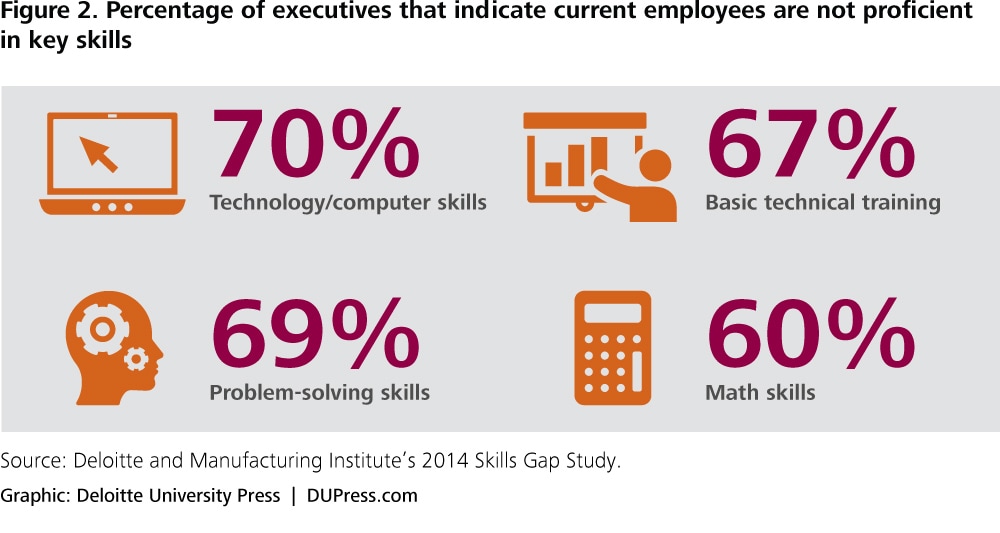Help wanted: American manufacturing competitiveness and the looming skills gap has been saved

Help wanted: American manufacturing competitiveness and the looming skills gap Deloitte Review Issue 16
27 January 2015
 Craig Giffi United States
Craig Giffi United States Ben Dollar United States
Ben Dollar United States Bharath Gangula United States
Bharath Gangula United States Michelle Drew Rodriguez United States
Michelle Drew Rodriguez United States
A skills gap is the US manufacturing sector’s Achilles’ heel, with nearly 3.5 million jobs at stake over the next decade. It is no longer a short-term issue of filling current hard-to-fill open positions, or one that can reasonably be expected to be solved in time by government policy-makers.

The future of manufacturing has been a topic of debate over the past decade. By the time the new millennium rolled around, many considered manufacturing a relic of the 20th century and not meaningful for developed nations in a 21st-century knowledge, information, and services economy. Making things had given way to other forms of adding value in a developed economy, and many developed nations, including the United States, watched, and often encouraged, their manufacturing sectors being displaced, outsourced, and diminished in favor of low-cost products and cleaner, supposedly smarter, and more sustainable service sectors such as financial services and health care. But the Great Recession that began in 2007–2008 caused a rethinking in established economies in North America, Western Europe, and Japan. It seemed manufacturing did indeed matter. Enormous effort and taxpayer money were spent to “save” the automobile industry and associated jobs in the United States, Canada, Germany, and Japan. Manufacturing jobs that had long been offshored were now coveted by both developed and emerging nations for their generally higher wages, strong multiplier effect on other jobs in the economy, positive impact on the prosperity of the middle class, and their critical linkage to a nation’s innovation ecosystem. Americans in particular were clamoring for more manufacturing jobs. In an annual survey of the US general public by Deloitte Consulting LLP and the Manufacturing Institute, conducted from 2009 through 2014, US citizens selected manufacturing first each and every year when asked to rank industries in which they would most prefer to create a thousand new jobs.1
Deloitte Review, issue 16
See the full issue
What is driving this manufacturing renaissance? Joint research by Harvard and MIT revealed that the competitive strength of a nation’s manufacturing sector is the most reliable predictor of a nation’s economic prosperity over the long term.2 In fact, their index of manufacturing complexity, or the robustness of a nation’s manufacturing sector, proved to be a more accurate predictor of a country’s economic prosperity than any other traditional measure. Further, they found that the more advanced a nation’s manufacturing sector (meaning the more complex and the higher the value of the products a nation can produce and trade) and its manufacturing processes and know-how, the more prosperous the nation and its citizens become. Finally, they found that virtually every nation in the world has been advancing its manufacturing capabilities over the past 50–60 years, and the most successful have had the greatest gains in traditional measures of economic prosperity such as GDP per capita (for example, China, Vietnam, and Thailand).
But what drives a nation’s or a company’s ability to engage in advanced manufacturing? Research we conducted in conjunction with the World Economic Forum, and separately with the US Council on Competitiveness, exploring the factors contributing most to manufacturing competitiveness identified a highly productive workforce, strong intellectual property protection policies, favorable financial and monetary policies, broad infrastructure, strong R&D capabilities, and established supply chains as important contributors to 21st-century advanced manufacturing competitiveness.3,4 But the most important factor identified was a nation’s ability to foster talent-driven innovation—that is, its ability to ensure a sufficient supply of talented workers, which enables companies to advance innovation agendas and produce more innovative, higher-value goods and services capable of winning in global markets. From researchers, scientists, and engineers to shop floor workers, the most critical ingredient identified by the thousands of executives worldwide participating in our research was the quality and availability of talent.
While many of the strengths and capabilities that propelled the United States during the 20th century remain, the growing skills gap threatens America’s competitiveness today and in the long term. An estimated 600,000 manufacturing jobs went unfilled in the United States in 2011, even as the nation was emerging from the economic downturn; manufacturers could not find enough workers literate in the science, technology, engineering, and math (STEM) disciplines necessary to effectively function in advanced manufacturing environments.5 This number could grow to over 2 million over the next decade, as 2.7 million workers retire and modest economic expansion creates the need for an additional 700,000 workers.6 A total of over 3.4 million manufacturing jobs will be available, and manufacturers will be able to fill fewer than half of these job openings due to the skills shortage. Unless it begins to close the growing skills gap and stem the loss of manufacturing knowledge resulting from retirements and fewer qualified candidates, the United States’ ability to continue to innovate and advance its 21st-century manufacturing capabilities may be in jeopardy.
Race among nations
Manufacturing is crucial to the US economy: For every dollar spent in manufacturing, $1.32 is added to America’s economy; 9 percent of the workforce is directly employed in manufacturing; and American manufacturing supports more than 12 million workers directly and 17.4 million jobs in total.7
At the same time, the United States isn’t the only nation that recognizes the economic importance and value of manufacturing. Developed and emerging nations are focused on improving their manufacturing competitiveness, attracting companies, and creating jobs, and as a result, they are challenging America’s position as a globally competitive manufacturing nation. Over the past few decades, emerging countries have taken advantage of their low labor costs and coupled them with incentives and enabling policies to support the growth of their manufacturing base and middle-class jobs. Over the last 20 years, manufacturing, which used to be concentrated in a few developed countries in North America, Europe, and Japan, has gradually moved to emerging, more cost-competitive markets, leading to an eightfold increase in exports from emerging economies in the last two decades.8
Deloitte Consulting LLP and the Manufacturing Institute polled a nationally representative sample of manufacturing companies about the state of talent in the US manufacturing industry. Eighty-four percent of manufacturing executives agree there is a talent shortage in US manufacturing, and they estimate that 6 out of 10 open skilled production positions are unfilled due to the shortage.
However, moving factories to low-cost destinations has had an unintended impact on American manufacturing and the workforce. Between 1990 and 2010, thousands of US factories closed, millions of manufacturing jobs were lost, and younger generations started looking elsewhere for better career opportunities.9 The combination of retirement and jobs displaced to the east over decades has resulted in a significant loss of embedded knowledge. As a result, there is a generational gap in technical skills in the United States as well as many European countries.10 Meanwhile, economies in Asia have experienced cost increases in labor, supply chain and logistics, and all forms of energy, with price differentials in electricity and natural gas increasing over the years.11,12 This has led manufacturers in developed nations, such as the United States, to consider “reshoring” facilities.
These factors represent an inflection point for American manufacturing. Since 2009, manufacturing has outperformed the overall economy.13 The economic rebound, declining energy costs due to the recent shale gas boom, and decreasing levels of offshoring in response to fading labor rate arbitrage advantages have all contributed to manufacturing growth in America.14 But the US labor force participation rate is declining.15 Baby Boomers continue to retire in droves. And the US pipeline of young talent is weak compared to many other manufacturing nations, both developed and emerging. Over the next decade, nearly 3.5 million manufacturing jobs will be available in the United States.16
While this should bode well for the United States’ long-term economic forecast, our research suggests manufacturers may be hard-pressed to fill all of those jobs. The issue that has concerned many for decades has finally reached a boiling point. The United States either must find and develop people to address the talent shortage or risk facing another wave of offshoring to places where talent is in greatest supply.
Deloitte Consulting LLP and the Manufacturing Institute polled a nationally representative sample of manufacturing companies about the state of talent in the US manufacturing industry. Eighty-four percent of manufacturing executives agree there is a talent shortage in US manufacturing, and they estimate that 6 out of 10 open skilled production positions are unfilled due to the shortage.
The talent shortage is already affecting US domestic firms as well as larger multinationals. Manufacturing output data from 2004 to 2013 reveal that US manufacturing lost a minimum of $17 billion annually due to unfilled positions. That figure exploded to over $45 billion in 2012 and 2013.17 Manufacturing executives believe the talent shortage will continue to impact their success. For example, nearly 80 percent of executives surveyed believe the talent shortage will affect their ability to meet growing customer demand, as well as develop new products and implement new technologies.
America’s manufacturing sector will likely require an estimated 3.4 million workers over the next decade (2015–2025) when accounting for the retirement of Baby Boomers and the forecast economic expansion. Of these, nearly 2 million jobs are expected to remain unfilled due to shortage of workers with the skills necessary to operate in a 21st-century advanced manufacturing environment (figure 1).
The magnitude of the skills shortage has not gone unnoticed, and the US government is taking steps to address the issue. New programs motivate businesses and educational institutions to create programs that develop America’s workforce by imparting relevant skills. For example, $450 million in job-driven training grants is being distributed in 2014 across nearly 270 US community colleges.18 However, these programs are not quick fixes, nor are they likely to be enough to tip the scale on their own. By the time the graduates of these new programs enter the workforce, the window of opportunity will have shrunk.
This skills gap may be manufacturing’s Achilles’ heel which—with nearly 3.5 million jobs at stake over the next decade, could swell to become the Achilles’ heel of the entire US economy. It is no longer simply a short-term issue of filling current hard-to-fill open positions, or one that can reasonably be expected to be solved in time by government policymakers. A holistic look at the issue, as well as an examination and understanding of the key variables contributing to the gap, will be crucial. The situation suggests the need for a new kind of workforce strategy that focuses on addressing prospective workers’ perceptions of manufacturing, optimizing the deployment of the existing workforce, augmenting recruitment practices, and, ultimately, building the talent pipeline.
The inflection point
The velocity of technological advances and innovation is also driving the need for new workers, as well as a highly skilled talent profile. Creating the demand for higher skills are streamlined production lines, coupled with increasingly automated processes and reliance upon advanced technologies that utilize fully connected computer-controlled processes, advanced robotics, and new manufacturing techniques such as 3D printing. As a result, manufacturers may face a shortage of qualified candidates emerging from the K-12 education system (particularly candidates with adequate STEM skills) as well as skill challenges within their existing workforce.
Manufacturers need to ramp up recruiting and talent development efforts and turn a watchful eye to finding “hyper-skilled” workers who have the requisite skills to keep up with today’s dynamic manufacturing environments, and who also possess traits that indicate adaptability, such as creativity, problem-solving skills, and critical thinking skills, to meet future needs. Otherwise, technological change and innovation will likely outpace the limited supply of skilled workers with the talent profile needed to meet today’s (and tomorrow’s) advanced manufacturing requirements.
We are at an inflection point. Developing multifaceted workforce programs that address the full spectrum of the skills gap can mean the difference between keeping and creating jobs in the United States and increasing reliance on offshore resources. Confronting the skills gap head-on requires a unified approach that includes business leaders, policy-makers, academicians, scientists, and labor leaders.
Are the issues really that complex?
A closer look at the drivers of the US skills gap suggests that the issues are complex in themselves, and even more complex in aggregate.
- Baby Boomers are retiring. There have been discussions about the impending “tsunami of retirements” for many years. Trends suggest that this wave of retirements is about to be unleashed. According to a recent Gallup study, the average retirement age of US workers is 64.19 While the average retirement age may increase slightly as the sluggish US recovery continues and nest egg worries mount, more than 2.7 million workers are likely to retire between 2015 and 2025.
- The pipeline of talent isn’t deep enough or developing quickly enough. Increasingly, K-12 students demonstrate a lack of proficiency in math and science. Remedying this issue is neither easy nor quick. The United States is lagging behind many other nations, particularly in math, science, and reading, as reflected in PISA test results.20 On average, over the next decade, between 3.2 million and 3.5 million students will graduate from US high schools annually.21 Few of these students will be qualified for careers in an advanced manufacturing environment and, based on test scores, few will have the necessary STEM skills for on-the-job training.
- Today’s workers are deficient in requisite skills. Executives indicate that current employees are deficient in technology, basic technical, and problem-solving skills. Seventy percent of executives report that their current workers do not have adequate technology and computer skills; over two-thirds indicate that they lack adequate problem solving skills; and 60 percent indicate that they lack sufficient math skills. Most troublingly, over two-thirds indicate that they lack basic technical training (figure 2).

- Business is expanding following the recession. Prior to 2009, the US manufacturing sector underperformed compared to the overall economy. The sector lost more than 2 million jobs between 2008 and 2010.22 However, since the recession ended, US manufacturing has grown. The share of GDP attributed to US manufacturing increased from 11.9 percent in 2009 to 12.4 percent in 2013.23 Looking to the future, data suggest that between 2015 and 2020, approximately 400,000 additional jobs will likely be created from natural growth or business expansion. By 2025, this number will likely grow to a cumulative 700,000 new jobs.24
- A new type of worker will be required because the skill set required is changing. As the industry has changed, the nature of the work has also changed. Manufacturers not only need to fill volumes of open positions—they need to fill those positions with skilled workers who can contribute effectively in a highly sophisticated and technical manufacturing environment. The pace of change that the industry is experiencing, combined with global competitive pressures, means that manufacturers will continue to expect more from their employees. Essentially, manufacturers need skilled workers who have the ability to master new, advanced technologies, work in highly collaborative team environments, use critical thinking and problem-solving skills, adapt to ever-changing environments, and embrace an attitude of never-ending learning.
Adding to the skills shortfall are three factors that also need to be addressed in the development of America’s strategy to help close the skills gap. First, US wages are growing at a slower rate than wages in other developed and emerging countries, potentially contributing to a lack of applicants. Second, labor force participation in the United States is decreasing. Simply put, people are leaving the workforce and not returning. And third, average American citizens do not view manufacturing as a viable career choice for themselves, nor are parents encouraging their children to explore manufacturing careers.
Talent shortage most severe among skilled production and highly skilled workers
To identify the occupations that are likely to face the greatest talent shortage, we asked executives to identify the business areas they think are most affected now and will be most affected by 2020. The results indicate that skilled production workers, engineers, researchers, and scientists are in short supply today. More worrisome, however, is that the gap is likely to worsen by 2020 (figure 3).
One of the categories forecast to be hardest hit may be skilled production workers (machinists, welders, cutters, and solderers), who accounted for 51 percent of manufacturing employment in 2012.25 Today, this category is experiencing the highest demand for skilled workers among all the categories in the study. Moreover, two-thirds of the executives participating in the study expressed concern that the impact of the shortage in this category could be felt through 2020.
To put this in perspective, the number of welders has already fallen from 570,000 in 1988 to fewer than 360,000 in 2012. Today, the average age of a welder in the United States is 55, and he or she is likely to retire within 10 years. Accounting for these retirements and the current talent pipeline, the American Welding Society estimates that, by 2020, there will be a shortage of 290,000 welding professionals.26 And this is just one segment within skilled production occupations. The shortfall is even more daunting when one examines the many types of trades within this cohort that are all facing the same issue.
The talent outlook for engineers, researchers, and scientists is also troublesome. Not only do one-third of the surveyed executives cite a severe shortage of engineers today, but nearly half expect this shortage to remain severe until 2020. Compounding this issue is the time our respondents indicate it takes to fill these jobs. They report that it can take an average of 94 days to fill engineering, research, and scientist positions.
Not just a numbers game—Finding, attracting, and retaining the right skills is at the heart of the matter
One of the key contributors to the skills shortage is the continued decline of interest among people with the right skills in pursuing manufacturing careers. The image of the manufacturing industry as “dirty, dumb, dangerous, and disappearing” has persisted despite vast innovations within manufacturing facilities that today are pristine environments housing highly advanced production machines and processes.27 These facilities are typically characterized by work cells composed of numerous computer-controlled, but operator-managed, machines and robots where one worker ensures that software, hardware, tooling, and materials all work together and to detailed specifications. Unfortunately, many young people do not recognize this evolution. As a result, manufacturing has an image problem that further exacerbates the skills gap.
This lack of awareness has contributed to a lack of interest from students.28 Lack of engagement from industry may have also led to insufficient manufacturing-related learning curricula.29 A rapid rate of innovation suggests that manufacturers face a growing and long-term need for a new type of worker who is STEM-literate, creative, and capable of problem solving. For those who are interested in working in manufacturing—and are aware of the opportunities—these dynamics can offer significant opportunity for long-term, financially and personally rewarding careers.
A new approach to recruiting, managing, and developing talent
Recruiting talent
Fifty-eight percent of executives reported they are either “currently revamping” (31 percent) or “considering changes to” (27 percent) their talent sourcing and recruiting strategies.30 Manufacturing executives should likewise consider new approaches to recruiting the right people.
Recruit from new sources: Manufacturers can recruit from relatively untapped sources of talent, including veterans and the long-term unemployed. Companies are instituting programs, such as “Get Skills to Work,” to enable the transition of veterans from military to civilian careers.31 Women are another untapped source: While they constitute nearly half of the US workforce, they account for less than a quarter of the workforce in manufacturing.32 Programs like the Manufacturing Institute’s STEP Ahead initiative provide an avenue for companies to motivate women leaders to pursue careers in manufacturing and to showcase the opportunities manufacturing can offer.
Accessing new sources of talent also means questioning old assumptions and challenging stereotypes about what skills are necessary and who may ultimately be successful. For example, do skilled production workers require college degrees, or can vocational programs produce qualified applicants? A recent article noted that while 60 percent of German young people train in “dual training” apprenticeship programs that combine secondary education with vocational training, only 5 percent of American youth do so.33 Manufacturers can also use readily available tools to bring the needed skills to the table. For example, the Manufacturing Institute’s system of certifications—designed by and for the industry, and endorsed by the National Association of Manufacturers—represents skill standards manufacturers can use while posting jobs and evaluating applicants. These certification standards also serve as a toolkit manufacturers can use in working with colleges and technical schools to ensure that training programs align with current and future job requirements.
Production workers come from different sources (junior colleges and vocational programs) than STEM professionals (traditional four-year colleges and universities). Skilled production workers can be “made” through vocational training programs; however, the challenge of finding STEM professionals must be addressed earlier in the educational pipeline. Only 16 percent of high school students are proficient in mathematics and interested in STEM careers. To address this deficiency, President Obama has set goals to develop, recruit, and retain 100,000 excellent STEM teachers over the next 10 years, and for colleges and universities to enable an additional 1 million students to graduate in STEM majors.34
Recruiting means marketing: Image matters when recruiting new talent. Moreover, the proliferation of benchmarking publications and social media provides prospective employees with a wealth of data about companies’ business models, talent management practices, and culture. According to the previously mentioned annual survey of the American public, Millennials (aged 19–33 years) indicated that some of the most “desirable” companies to work for are in the technology industry, where innovative products or software solutions are highly visible. In addition, 64 percent of them report that one of their career priorities is “to make the world a better place.”35 Manufacturers can increase their attractiveness to these applicants by highlighting the link between innovative products and societal outcomes (such as sustainability and infrastructure development). Another recent study found that Millennials seek to gain skills that enhance their future career prospects.36 Manufacturers can enhance their attractiveness to this demographic by marketing the use of additive manufacturing (3D printing) technologies, advanced analytics, robotics, and other innovations. Finally, Millennials value a collaborative, flexible, and open work environment where technology is central. Manufacturers can market their work environments in innovative ways that highlight these traits. One major manufacturer, for example, has used gaming technology to help prospective applicants learn about its work environment and culture.37

Managing talent
Manufacturing companies can take advantage of HR data and empower their HR leadership team to help achieve business goals.
Manage the talent pipeline like a supply chain: Analytics-driven approaches to workforce planning can enable companies to get ahead of talent shortages in the same way that they manage lead times in the supply chain. Changes in economic conditions or business strategy, or a decision to introduce a new product, may require companies to adjust workforce strategies. For example, the decision to introduce a new product using a disruptive technology will require a company to forecast the competencies required throughout the new product’s life cycle, assess its current employees for required skills to identify competency gaps, and design strategies for closing those gaps. As in supply chain management, one size does not fit all. This model allows manufacturers to apply lean concepts such as “just in time” and “right part, right time” beyond manufacturing and production to the management of their workforce. A successful program may include a mix of balance sheet employees (in whom the company has made a long-term investment to “buy”), consultants with specific and/or high-priced skill sets that the organization needs to only “rent,” and contractors whom the organization may not have the time or resources to develop and who represent “variable capacity” that can be flexed up and down based on program needs. Managing this talent requires standardizing roles, skill descriptions, and competencies (for example, employing the National Association of Manufacturers’ manufacturing competency model) to support both internal resource deployment/redeployment and external sourcing of resources (for example, from schools that train students in specific competencies).
This skills gap may be manufacturing’s Achilles’ heel which—with nearly 3.5 million jobs at stake over the next decade, could swell to become the Achilles’ heel of the entire US economy. It is no longer simply a short-term issue of filling current hard-to-fill open positions, or one that can reasonably be expected to be solved in time by government policymakers. A holistic look at the issue, as well as an examination and understanding of the key variables contributing to the gap, will be crucial.
Redesign and re-skill the HR function: Traditionally, HR employees focus on managing day-to-day activities such as employee salary and benefits administration, administrative activities (such as processing human resources information system changes), and employee relations. Manufacturing HR departments should transition from delivering HR services to designing and driving HR strategies where HR outcomes are business outcomes. The HR function can be more valuable to the organization when it is empowered and responsible for designing and driving strategies to recruit, develop, and retain employees. There are some key principles that can guide manufacturing companies in redesigning their HR functions:
- Establish a service delivery framework and automate transactions for day-to-day employee needs. Until HR professionals have the ability to step away from day-to-day tasks, they will be not be able to provide real value to the business.38
- Embed HR professionals in the business and provide strategic human capital consultative services. This move will address the human capital challenges unique to each department. For example, many engineers struggle when promoted to manager, a transition often complicated by a lack of training.39 An HR specialist who is well-integrated with the business could pinpoint this challenge and design appropriate talent programs to address it.
- Reduce the need for HR generalists, and create HR specialists. When individuals can focus on developing skills in specific areas, the entire department can work like a “network of expertise.”40 For example, empowering one individual to focus solely on recruiting can help the organization develop deep expertise in areas that matter most, such as supporting the development of local STEM talent and attracting top candidates. All of these changes can help HR transition from “just getting by” to developing strategies and driving changes that bridge the skills gap.
Developing talent
Unlike the post-World War II boom when beginning a career meant committing to long-term employment, people today change jobs more frequently.41 Retention beyond five years is uncommon. Somewhat counterintuitively, though, employee development is one of the biggest drivers of retention and engagement.42 Manufacturers can invest in training and development programs to build the capabilities needed to meet business goals and improve retention. To paraphrase a recent discussion with a manufacturing leader: “I am less afraid of developing my people and having them leave than I am of not developing them and having them stay.”
Foster long-term career development and growth: Learning doesn’t happen only through programs and courses. Manufacturing companies must shift from “pushing” training to employees to allowing employees to “pull” the information they need and want. Manufacturers need to evaluate what capabilities are required to achieve business outcomes and invest in learning, using the right mix of media—hands-on training, apprenticeships, virtual classrooms, traditional classrooms, and social media. Employees should be able to find information on their own in real time, educate themselves, and share knowledge with others. Online or mobile portals allow employees to take training at any time, and new knowledge tools let them literally “Google” the right answers.43 Employees can also develop skills through their work networks, by seeking feedback from peers, and by working with managers for coaching and mentoring. It is important to evaluate the learning function with the same rigor as other functions—funding and expanding programs that deliver results and eliminating those that do not. Finally, companies must create reward structures that focus employees on continuous versus episodic learning, and that create an expectation of learning throughout one’s career. Nissan, for example, as part of its corporate strategy, helps employees design their own careers by creating a culture of continuous learning. Employees gain specific skills not only in their area, but also participate in training that extends their skills in the field of their choice. Once they acquire new skills, they apply for positions in the area of their interest.44
Invest in experiential development: An important part of development comes from employees’ experiences. MiIllenials value rapid advancement, flexibility, and mobility across a variety of assignments.45 Unfortunately, these characteristics are not traditionally associated with manufacturing. This can be changed through the implementation of non-traditional developmental assignments and career paths. Companies can facilitate short-term assignments or deployment outside current roles. The founder of LinkedIn, Reid Hoffman, has popularized the term “tours of duty” to describe this concept. Employees on tours of duty in different parts of the company, in other regions, or on cross-functional teams learn new skills rapidly. These experiences can help make employees both more capable and more loyal.46
With US manufacturing likely facing a shortfall of 2 million workers in the next decade, it will be essential to examine the impact of the skills gap and take a new approach to talent management. The contributing factors—a shortage of workers with adequate STEM skills, the impending onslaught of Baby Boomer retirements, expected industry expansion, and a lack of interest in manufacturing among the next generation of workers—cannot be ignored by business leaders or government policymakers.
© 2021. See Terms of Use for more information.






